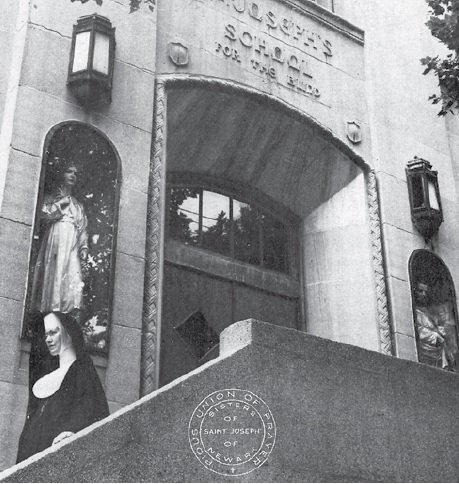St. Joseph School for the Blind: Nurturing Abilities for over 100 Years
by Cristina Turino
History and Roots
Since their earliest days, the Sisters of St. Joseph of Peace had expressed an interest in the care and instruction of the blind poor. At the same time, Rosalie Grant, a similarly motivated, Catholic parishioner, was given permission to open a refuge in Jersey City. To systemize the endeavor, Bishop Wigger of Newark invited the Congregation to take the reins of the three year-old Home for the Blind in 1889. This initiated the founding of St. Joseph’s School for the Blind, the first Catholic school for blind children on the East Coast, which still stands today as an ambitious innovator in the education of the visually-impaired.
In 1891, Mother Ignatius and four sisters set out to operate the Home, formally educate the children, and collect alms to sustain it all. They hired a blind teacher to instruct the children in braille and other subjects. Eventually, a couple of the older students assisted in lessons, as others translated books into braille for their library. Boys were taught on the fourth floor of the newly constructed home, while girls studied at three nearby cottages. Although initially serving the residents of the Home, the school soon welcomed boarding students from all-over the nation and other countries. Their education was afforded by donations, but largely by the revenue accrued from the sisters’ publication, The St. Joseph’s Messenger and Advocate of the Blind.
By 1929, the Congregation built a five-story structure that could accommodate their growing student body. The building had 12 classrooms, rooms for vocational study, a library, gymnasium, infirmary, indoor swimming pool, roof garden and dormitories. The children were instructed by sisters in the Diocesan curriculum and took all the required exams. There was an emphasis on braille, arithmetic, and the use of models and reliefs for tactile visualization. Students also partook in music, vocal, dance, art and crafts classes and received speech and physical therapies and counseling. They were often taken on cultural and recreational excursions and participated in the Boy or Girl Scouts. Pupils attended from first through twelfth grade, though some studied at local Catholic high schools while still lodging at the School for the Blind. A few enrolled in university. Others elected to learn trades at the Home, like mattress-making or weaving.
As schools became better equipped at accommodating blind children, the School for the Blind shifted its focus to integrating current students into society and working exclusively with visually-impaired children with multiple disabilities, who had fewer resources. In 1960, they began transitioning the population of 45, mostly boarders, into their local schools. Ready children were sent to a neighboring elementary school or to their district high schools. In conjunction with the Mount Carmel Guild, which provided assistance and brailled materials, itinerant teachers oriented the children in their new environments and visited their schools on selected days for 50-minute lessons in braille fundamentals or to supply books.
The second part of the mission required the gradual transformation of the institute. The staff slowly grew with the introduction of more sisters and employment of experts in mobility, psychiatry, social work, special education, and other specialties. Sisters undertook coursework in standard and emerging methods in special needs education and received certifications. The evolving curriculum was tailored to meet every child’s specific needs and abilities. And, classroom space was reconfigured as students were encouraged to live at home. Still, for a short period, the lack of space inhibited the acceptance of new students. Meanwhile, a new law resulted in most of the educational fees being covered by state funds, leaving the school to gather the rest via fundraisers and donations.
In the last 58 years, St. Joseph’s School for the Blind has continued to change and grow to enhance the lives of visually-impaired children with multiple disabilities by nurturing their abilities. In 2007, it relocated to a 75,000 square foot, state-of-the-art facility, where they currently serve 63 students aged 3-21 in day programs for preschool through high school and 61 children under three-years old in the Early Intervention Program. The staff is comprised of 60 qualified educators, therapists, specialists, social workers, and other professionals. Since 2012, they have also provided services and activities for adults 21 and older with special needs.
This article appeared in the Autumn 2018 issue of Living Peace.


